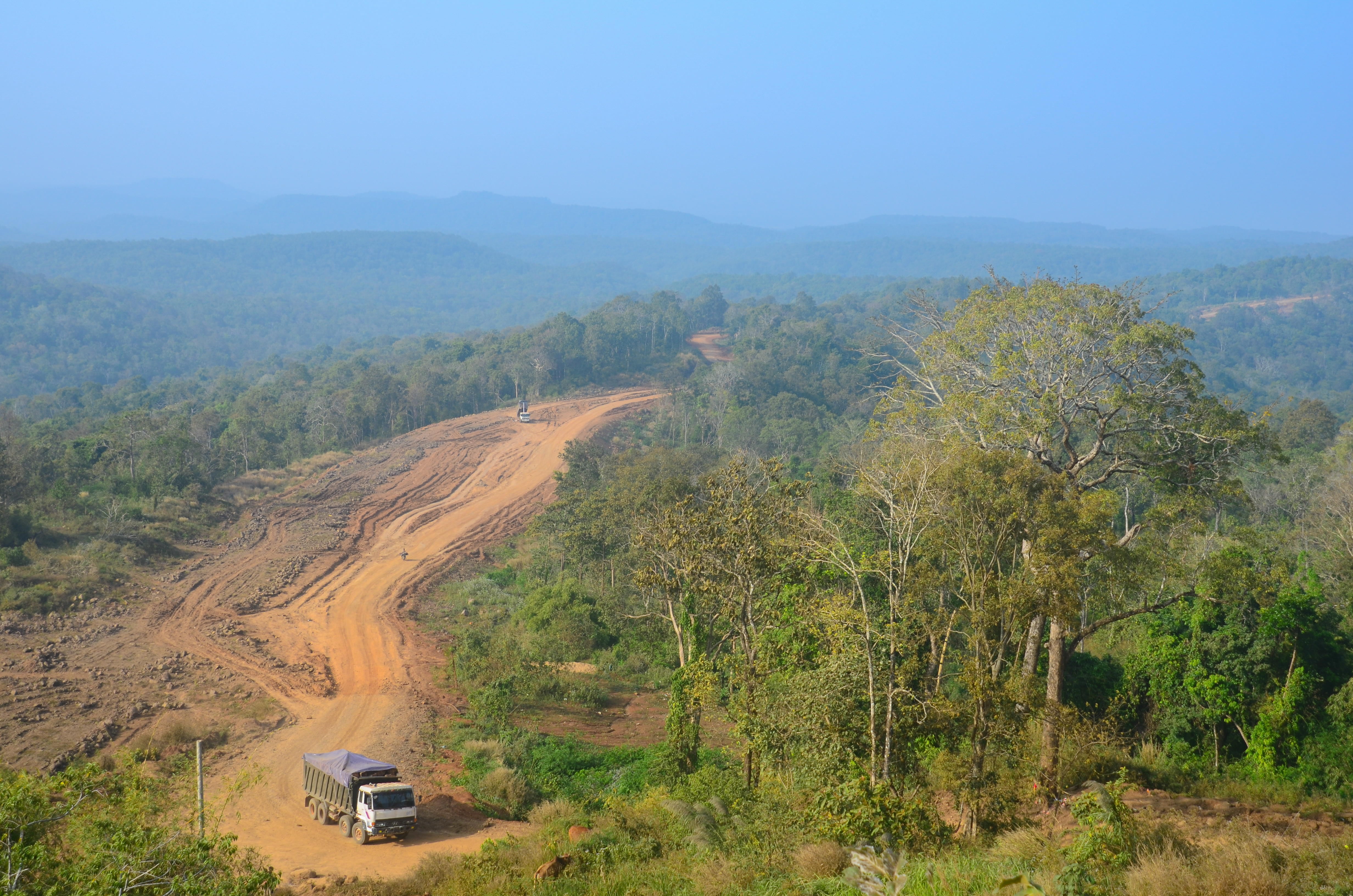
រថយន្តដឹកឈើក្នុងព្រៃការពារមណ្ឌលគិរី ប្រទេសកម្ពុជា។ រូបភាព ថតដោយ Global Water Forum, នៅថ្ងៃទី២៣ កុម្ភៈ ២០១៤។ ក្រោមអាជ្ញាប័ណ្ណ CC BY-NC-SA 2.0
ប្រទេសកម្ពុជាត្រូវបានគេព្រួយបារម្ភយ៉ាងខ្លាំងអំពីការកាប់ព្រៃឈើ។ ខណៈដែលប្រទេសនេះកំពុងស្វែង រកការអភិវឌ្ឍឆាប់រហ័សលើវិស័យសេដ្ឋកិច្ច ព្រៃឈើជាច្រើនត្រូវបានគេចាត់ទុកជាធនធានទ្រព្យសម្បត្តិជាតិ។ ដើម្បីជួយធានាដល់ការគ្រប់គ្រងធនធានទាំងនេះប្រកបដោយនិរន្តរភាព រដ្ឋាភិបាលបានបង្កើតច្បាប់គ្រប់គ្រងព្រៃឈើដែលត្រូវបានផ្តល់សច្ចាប័ននៅថ្ងៃទី ១៥ ខែសីហា ឆ្នាំ២០០២។
ច្បាប់នេះសង្កត់ធ្ងន់ពីសារៈសំខាន់នៃព្រៃឈើសម្រាប់ជាគុណប្រយោជន៍ដល់សង្គម សេដ្ឋកិច្ច និងបរិស្ថាន ក៏ដូចជា តួនាទីរបស់វានៅក្នុងប្រព័ន្ធជីវៈចម្រុះ និងបេតិកភ័ណ្ឌវប្បធម៌1។
| « រាជរដ្ឋាភិបាលនៃព្រះរាជាណាចក្រកម្ពុជាចាត់ទុកថាការសម្រេចបាននូវការគ្រប់គ្រង និងការអភិរក្សនៃធនធានព្រៃឈើសម្រាប់ប្រព័ន្ធអេកូឡូស៊ី សង្គម និងសេដ្ឋកិច្ច ជាសសរស្តម្ភនៃសុខុមាលភាពដ៏ធំមួយ ដែលរួមចំណែកដោយផ្ទាល់ដល់ការការពារបរិស្ថាន ការកាត់បន្ថយភាពក្រីក្រ និងការអភិវឌ្ឍសេដ្ឋកិច្ចសង្គម។ » |
ក្រសួងកសិកម្ម រុក្ខាប្រមាញ់ និងនេសាទ គឺជាអាជ្ញាធរដែលមានសិទ្ធិអំណាចផ្លូវច្បាប់ជាមួយនឹងយុត្តាធិការទូទៅលើគោលនយោបាយ និងការគ្រប់គ្រងព្រៃឈើ។ ការងារទាំងនេះត្រូវបានចាត់ចែងដោយរដ្ឋបាលព្រៃឈើ។
ក្រមខណ្ឌគតិយុត្តិនៅកម្ពុជា
ច្បាប់ស្តីពីព្រៃឈើត្រូវបានបង្កើតឡើងនៅក្នុងឆ្នាំ ២០០២ បន្ទាប់ពីមានច្បាប់ស្តីពីការគ្រប់គ្រងដីធ្លីឆ្នាំ ១៩៩២ និងច្បាប់ស្តីពីការគ្រប់គ្រងលើធនធានធម្មជាតិឆ្នាំ ១៩៩៦។ ច្បាប់ស្តីពីព្រៃឈើគ្របដណ្តប់ផ្នែកពិសេសដូចជា ការគ្រប់គ្រងព្រៃឈើ ការផ្តល់សម្បទានព្រៃឈើ និងនិស្សារណកម្មធនធាន។ ព្រៃសហគមន៍ ក៏ជាប្រធានបទមួយចម្បងនៅក្នុងគោលនយោបាយព្រៃឈើផងដែរ។ វាត្រូវបានគាំទ្រដោយច្បាប់ជាលាយលក្ខណ៍អក្សរបន្ថែមយ៉ាងច្រើនដែលផ្តល់អំណាចដល់គោលនយោបាយវិស័យព្រៃឈើជាតិ2។
វិស័យព្រៃឈើ គឺត្រួវបានបែងចែងទៅជាពហុតំបន់3 ហើយតំបន់នីមួយៗមានច្បាប់ដែលពាក់ព័ន្ធរបស់វាដែលត្រូវបានបានដាក់ និងអាទិភាពក្នុងការគ្រប់គ្រង៖
សម្បត្តិព្រៃឈើអចិន្ត្រៃយ៍ | ព្រៃបម្រុងទុកអចិន្ត្រៃយ៍ | ព្រៃផ្តល់ផល |
| ព្រៃការពារ | ||
| ផ្ទៃដីព្រៃសម្រាប់ផ្ទេរដើម្បី គោលបំណងអភិវឌ្ឍផ្សេងទៀត | ||
| ព្រៃឯកជន | ||
- ព្រៃផ្តល់ផលត្រូវបានរៀបចំដើម្បីធានាដល់ផលិតកម្មផលប្រកបដោយនិរន្តភាព។ សម្រាប់ព្រៃប្រភេទនេះមានជាអាទិ៍ ព្រៃសម្បទាន និងព្រៃសហគមន៍។
- ព្រៃការពារ គឺត្រូវបានការពារសម្រាប់គុណតម្លៃដល់ប្រព័ន្ធអេកូឡូស៊ី និងធនធានធម្មជាតិ។
- ផ្ទៃដីព្រៃសម្រាប់ផ្ទេរដើម្បីគោលបំណងអភិវឌ្ឍផ្សេងទៀត គឺជាព្រៃដែលមិនទាន់បានចាត់ចូលទៅក្នុងការប្រើប្រាស់របស់វិស័យណាមួយនៅឡើយ។
- ព្រៃឯកជន គឺត្រូវបានគ្រប់គ្រងក្រោមការសម្រេចចិត្តរបស់ម្ចាស់កម្មសិទ្ធិព្រៃទាំងនោះ។
ការផ្តល់សម្បទានទាក់ទងនឹងព្រៃឈើនៅកម្ពុជាមានពីរប្រព័ន្ធ។ ដីសម្បទានសេដ្ឋកិច្ច និងព្រៃសម្បទាន គឺជាការជួលក្នុងរយៈពេលវែង ដែលអនុញ្ញាតដល់សកម្មភាពជាច្រើន។ ព្រៃសម្បទាន ត្រូវបានដាក់ដេញថ្លៃជាសាធារណៈ និងមិនត្រូវកំណត់ឱ្យលើសពី ៣០ឆ្នាំនោះទេ។ គោលបំណងនោះគឺ ដើម្បីទាញយកទំហំព្រៃឱ្យកាន់តែធំជាងមុនមកស្ថិតនៅក្រោមការគ្រប់គ្រង និងដើម្បីកាត់បន្ថយការកាប់ឈើខុសច្បាប់ ក៏ដូចជាដើម្បីបង្កើនតម្លៃឈើ4។
សិទ្ធិប្រើប្រាស់ជាប្រពៃណី និងសិទ្ធិចេញចូលទៅកាន់តំបន់ព្រៃសម្បទាត្រូវតែធានាដោយសម្បទានិក។ ប្រហាក់ប្រហែលនឹងដីសម្បទានសេដ្ឋកិច្ចដែរ ការសម្បទានព្រៃចាំបាច់ត្រូវតែមានការសិក្សាពីផលប៉ះពាល់បរិស្ថាន និងផលប៉ះពាល់សង្គម។
រដ្ឋបាលព្រៃឈើ
ការគ្រប់គ្រងព្រៃឈើ គឺជាទំនួលខុសត្រូវនៃរដ្ឋបាលព្រៃឈើ។ អាជ្ញាធររដ្ឋាភិបាលនេះ ជាអ្នកទទួលបន្ទុកអនុវត្តន៍ច្បាប់ឆ្នាំ ២០០២ និងអនុក្រឹត្យ ក៏ដូចជាប្រកាសនានានៃច្បាប់នេះ។ ស្ថាប័ននេះត្រូវបានបែងចែកជា ៥កម្រិត៖ ថ្នាក់កណ្តាល អធិការដ្ឋានថា្នក់តំបន់ ខ័ណ្ឌ ផ្នែក និងសង្កាត់រដ្ឋបាលព្រៃឈើ។
ភារកិច្ចជាបឋមនៃរដ្ឋបាលព្រៃឈើ គឺដើម្បីធានាដល់ការគ្រប់គ្រងសម្បត្តិព្រៃឈើអចិន្ត្រៃយ៍5ប្រកបដោយនិរន្តរភាព ដោយ៖
- សិក្សាប្រមូលទិន្នន័យលើព្រៃឈើ
- វាយតម្លៃព្រំប្រទល់ ដោយសហការជាមួយក្រសួងរៀបចំដែនដីនគរូបនីយកម្ម និងសំណង់
- ចាត់វិធានការសមស្របដើម្បីទប់ស្កាត់ការបំផ្លិចបំផ្លាញព្រៃឈើ
- បង្កើនការអប់រំដល់ប្រជាពលរដ្ឋជាសាធារណៈ
- រៀបចំ និងអនុវត្តន៍ផែនការគ្រប់គ្រងព្រៃឈើជាតិនៅថ្នាក់នីមួយៗនៃរដ្ឋបាលព្រៃឈើ។
ការអភិរក្សសត្វព្រៃ ក៏ជាទំនួលខុសត្រូវមួយក្នុងចំនោមទំនួលខុសត្រូវផ្សេងទៀត ជាពិសេសតាមរយៈការគ្រប់គ្រងការបរបាញ់សត្វព្រៃ។
រដ្ឋបាលព្រៃឈើទទួលបន្ទុកចាត់វិធានការលើរាល់សកម្មភាពគ្រប់គ្រងព្រៃឈើ។ វាចាំបាច់ត្រូវមានញញួរត្រាក្នុងការបែងចែកឱ្យដាច់រវាងការកាប់ឈើស្របច្បាប់ និងការកាប់ឈើខុសច្បាប់។
រដ្ឋបាលនេះប្រកាសការអនុញ្ញាតលើការប្រមូលផលព្រៃឈើ និងតាមប្រភេទផលិតផលសម្រាប់គោល បំណងពាណិជ្ជកម្ម។ វារាប់បញ្ជូលទាំងការហាមឃាត់ការប្រមូលផលផលិតផលព្រៃឈើមួយចំនួននៅ ក្នុងតំបន់ព្រៃបម្រុងអចិន្ត្រៃយ៍រួមមាន ប្រភេទដើមឈើកម្រ ឬប្រភេទដើមឈើដែលផ្តល់ទិន្នផលជ័រដែល មានតម្លៃខ្ពស់។
មានតែសហគមមូលដ្ឋានប៉ុណ្ណោះដែលមានសិទ្ធិក្នុងការប្រមូលផលព្រៃឈើ និងត្រូវប្រមូលទៅតាមប្រភេទផលិតផលដែលមាននៅក្នុងតំបន់ព្រែការពារ ប្រសិនបើផលប៉ះពាល់បរិស្ថានរបស់សកម្មភាពទាំងនោះនៅមានកម្រិត។
ការដាក់ទោសទណ្ឌអាចត្រូវបានអនុវត្តដោយរដ្ឋបាលព្រៃឈើ6 តាមរយៈការពិន័យ ឬការជួសជុលការខូចខាត។ អ្នកដែលប្រព្រឹត្តបទល្មើសអាចជាប់ពន្ធនាគាររហូតដល់ ១០ឆ្នាំ និងពិន័យជាប្រាក់រហូតដល់ ១០០លានរៀល (ប្រហែល ២៥,០០០ដុល្លារ)។
ក្នុងឆ្នាំ ២០០៨7 ពាណិជ្ជកម្មកាបូនព្រៃឈើបានក្លាយទៅជាទំនួលខុសត្រូវមួយក្នុងចំនោមទំនួលខុសត្រូវផ្សេងទៀត នៃរដ្ឋបាលព្រៃឈើ។ ការស្ទុកកាបូនក្នុងព្រៃត្រូវបានផ្តល់គុណតម្លៃ ដោយយោងតាមសន្ធិសញ្ញាក្រុងក្យូតូឆ្នាំ ២០០៧។
កម្មវិធីព្រៃឈើថ្នាក់ជាតិ
កម្មវិធីព្រៃឈើថ្នាក់ជាតិ (NFP) ត្រូវបានបើកសម្ភោធនៅក្នុងឆ្នាំ ២០១០ ហើយត្រូវបានកំណត់គម្រោងសម្រាប់រយៈពេល ២០ឆ្នាំ ដែលត្រូវបានបែងចែងជាកម្មវិធីតំបន់ធំៗចំនួន ៦8 ៖
- បោះបង្គោលព្រៃឈើ, ចែកចំនាត់ថ្នាក់ និងការចុះបញ្ជី
- អភិរក្ស និងអភិវឌ្ឍន៍ធនធានព្រៃឈើ និងជីវៈចម្រុះ
- ការអនុវត្ត និងអភិបាលកិច្ចលើច្បាប់ស្តីពីព្រៃឈើ
- ព្រៃសហគម
- ការអភិវឌ្ឍសមត្ថភាព និងការស្រាវជ្រាវ
- ផ្តល់ហរិញ្ញប្បទានព្រៃឈើប្រកបដោយនិរន្តរភាព។
កម្មវិធីទាំងនេះត្រូវបានបែងចែងទៅជាកម្មវិធីតូចៗបន្ទាប់ទៀត។ កម្មវិធីព្រៃឈើថ្នាក់ជាតិ គឺកំពុងផ្តល់ឱ្យនូវគោលដៅយុទ្ធសាស្ត្រសម្រាប់ការគ្រប់គ្រងព្រៃឈើដើម្បីសម្រេចឱ្យបាននូវគោលដៅអភិវឌ្ឍថ្នាក់ជាតិ។ ក្នុងករណីដែលការអនុវត្តច្បាប់ស្តីពីព្រៃឈើនៅក្នុងតំបន់ការពារ ក្រសួងបរិស្ថានគឺត្រូវបានផ្តល់ទំនួលខុសត្រូវក្នុងការប្រើប្រាស់ច្បាប់នេះដើម្បីគ្រប់គ្រងតំបន់នោះ។
គោលដៅធំៗពីរនៃការគ្រប់គ្រងព្រៃឈើគឺ ដើម្បីស្វ័យគ្រប់គ្រងហិរញ្ញវត្ថុ និងដើម្បីធ្វើឱ្យគម្របព្រៃឈើមាន ៦០%ឡើងវិញ នៅឆ្នាំ ២០២៩9។ យ៉ាងណាមិញ ភាពចម្រូងចម្រាសនៃការគណនាតួរលេខនេះនៅតែមាន ដោយហេតុថា មានមតិមិនស្របគ្នាលើកឡើងថា តើដំណាំកៅស៊ូគួរតែរាប់បញ្ជូលទៅក្នុងការគណនានោះដែរ ឬយ៉ាងណា10។
ការប្រឈម និងឱកាស
អង្គការស្បៀង និងកសិកម្ម (FAO) កត់សម្គាល់ឃើញការប្រឈម11មួយចំនួនរួមមាន៖ សមភាពនៃការបែងចែងប្រយោជន៍ ការកាន់កាប់ដីធ្លីមិនមានភាពរឹងមាំ និងការរំលោភយកដីព្រៃ។ ការប្រឈមទាំងនេះ គឺជាលទ្ធផលបណ្តាលមកពីបញ្ហានៃការអនុវត្តគោលនយោបាយព្រៃឈើ12។ ទោះជាយ៉ាងណា មានកំណែទម្រង់ជាច្រើននៅក្នុងវិស័យព្រៃឈើកំពុងតែដំណើរការ13។
នៅពាក់កណ្តាលឆ្នាំ ២០១៥ រាជរដ្ឋាភិបាលបានប្រកាសពីជំហានកាត់បន្ថយរយៈពេលនៃការផ្តល់សម្បទានដីសេដ្ឋកិច្ច ពី ៩៩ឆ្នាំ ឱ្យនៅត្រឹមតែ៥០ឆ្នាំប៉ុណ្ណោះ ហើយនៅដើមឆ្នាំ ២០១៦ រាជរដ្ឋាភិបាលបានបង្ហាញពីគោលបំណងរបស់ខ្លួនក្នុងការដាក់ដីសម្បទានសេដ្ឋកិច្ច14 ១លានហិកតាទៅក្នុងសម្បទានដីសង្គមកិច្ចវិញ។
នៅខែមីនា ឆ្នាំ ២០១៦ រាជរដ្ឋាភិបាលបានសម្រេចក្នុងការបែងចែងឱ្យច្បាស់ពីការទទួលខុសត្រូវរវាងក្រសួងកសិកម្ម រុក្ខាប្រមាញ់ និងនេសាទ និងក្រសួងបរិស្ថាន15។ តំបន់សម្បទានដីសេដ្ឋកិច្ចដែលបច្ចុប្បន្ននេះ ស្ថិតក្រោមសមត្ថកិច្ចនៃក្រសួងបរិស្ថាន នឹងត្រូវបានផ្ទេរឱ្យទៅស្ថិតនៅក្រោមការគ្រប់គ្រងរបស់ក្រសួងកសិកម្ម រុក្ខាប្រមាញ់ និងនេសាទ ខណៈដែលតំបន់ការពារ និងអភិរក្សធម្មជាតិ ដែលបច្ចុប្បន្ននេះស្ថិតក្រោមការគ្រប់គ្រងរបស់ក្រសួងកសិកម្ម រុក្ខាប្រមាញ់ និងនេសាទ នឹងត្រូវបានផ្ទេរឱ្យទៅក្រសួងបរិស្ថានវិញ។
មួយខែក្រោយមក តាមសំណើរដែលធ្វើឡើងដោយក្រសួងបរិស្ថាន រាជរដ្ឋាភិបាលនៃព្រះរាជាណាចក្រកម្ពុជាកំពុងគ្រោងនឹងដាក់តំបន់ព្រៃចំនួន ៥នៅក្រោមតំបន់ការពារធម្មជាតិ16។ ក្រោមការផ្តួចផ្តើមនៃក្រសួងបរិស្ថាន សិក្ខាសាលាថ្នាក់ជាតិមួយត្រូវបានរៀបចំឡើងដើម្បីប្រមូលមតិយោបល់នានាពីភាគីពាក់ព័ន្ធ សម្រាប់ការចែកចំណាត់ថ្នាក់តំបន់ព្រៃទាំងនេះទៅក្នុងប្រភេទ ដែលសមស្របនៃតំបន់ការពារធម្មជាតិ ហើយអនុក្រឹត្យមួយត្រូវបានធ្វើឡើងស្តីពីការបង្កើតនេះ17។
ធ្វើបច្ចុប្បន្នភាពថ្ងៃទី ១៣ មិថុនា ២០១៦
ទាក់ទងនឹងគោលនយោបាយព្រៃឈើ និងអភិបាលកិច្ច
ឯកសារយោង
- 1. នាយករដ្ឋមន្ត្រី ហ៊ុន សែន “សេចក្តីថ្លែងការណ៍នៃរាជរដ្ឋាភិបាលស្តីពីគោលនយោបាយវិស័យព្រៃឈើជាតិ”, ថ្ងៃទី ២៦ កក្កដា ២០០២។ http://www.forestry.gov.kh/Law/ForestPolicy.html
- 2. ដូចឯកសារយោងខាងដើម។
- 3. ច្បាប់ស្តីពីព្រៃឈើឆ្នាំ ២០០២, រាជរដ្ឋាភិបាលនៃព្រះរាជាណាចក្រកម្ពុជា, មាត្រាទី ១០។ http://www.cambodiainvestment.gov.kh/law-on-forestry_020930.html
- 4. គឹម ផាត, N., Ouk, S., Uozumi, Y., និង Ueki, T. (២០០១); អង្គការស្បៀង និងកសិកម្ម (២០០២ និង២០០៥); ធនាគារពិភពលោក (២០០៥ និង២០០៦)។ https://www.cbd.int/doc/case-studies/inc/cs-inc-cambodia-technical-en.pdf
- 5. ច្បាប់ស្តីពីព្រៃឈើឆ្នាំ ២០០២, រាជរដ្ឋាភិបាលនៃព្រះរាជាណាចក្រកម្ពុជា, ជំពូកទី ៣។ http://www.cambodiainvestment.gov.kh/law-on-forestry_020930.html
- 6. ច្បាប់ស្តីពីព្រៃឈើឆ្នាំ ២០០២, រាជរដ្ឋាភិបាលនៃព្រះរាជាណាចក្រកម្ពុជា, ជំពូកទី ១៤ និងទី ១៥។ http://www.cambodiainvestment.gov.kh/law-on-forestry_020930.html
- 7. អនុក្រឹត្យលេខ ១៨៨ ស្តីពីការកែសម្រួល អគ្គនាយកដ្ឋាននៃក្រសួង ទៅជាអគ្គលេខាធិការដ្ឋាន https://server2.maff.gov.kh/parse/files/myAppId5hD7ypUYw61sTqML/884bacfe654521e67d4ff16b3622ec54_1502934557.pdf
- 8. ការអនុវត្តន៍កម្មវិធី, កម្មវិធីព្រៃឈើជាតិ ២០១០-២០២៩, រាជរដ្ឋាភិបាលនៃព្រះរាជាណាចក្រកម្ពុជា, http://www.cdccrdb.gov.kh/cdc/documents/Sector_Strategy/6_Forestry_Reform/National_Forest_Programme_2010_2029_Eng.pdf
- 9. ដូចឯកសារយោងខាងដើម។
- 10. វីល ថាកឃើរ ២០១៥. “លើកស្បៃមុខ៖ បន្លំបំផ្លាញព្រៃឈើក្នុងរូបភាពជាកសិកម្មនៅកម្ពុជា”, និន្នាការព្រៃឈើ, ចុះផ្សាយ ១៣ សីហា ២០១៥។ http://forest-trends.org/blog/2015/08/13/lifting-the-veil-deforestation-disguised-as-agriculture-in-cambodia/
- 11. “ការសិក្សាពីទស្សនៈវិស័យព្រៃឈើកម្ពុជា”, រដ្ឋបាលព្រៃឈើ។ កិច្ចដំណើរការនីតិវិធីសម្រាប់ APFOS II, ២០១០, អង្គការស្បៀង និងកសិកម្ម។ http://www.fao.org/docrep/014/am627e/am627e00.pdf
- 12. -ហ្សូមបឺ ផីតឺ ២០១៣. “ការបាត់បង់ព្រៃឈើនៅកម្ពុជាជារឿងមួយក្នុងចំនោមរឿងដ៏អាក្រក់បំផុតក្នុងពិភពលោក”. កាសែត ឌឹ ខេមបូឌា ដេលី, ចុះថ្ងៃទី ១៩ វិចិ្ឆកា ២០១៣។ https://www.cambodiadaily.com/archives/loss-of-forest-in-cambodia-among-worst-in-the-world-47259/
- 13. ម៉ៃ ទិត្យថារ៉ា, ២០១៦. “រាជរដ្ឋាភិបាលបានស្នើរឱ្យការពារព្រៃប្រមាណ ១លានហិកតា”, កាសែតខ្មែរថាមស៍,ចុះថ្ងៃទី ៣០ មីនា ២០១៦។ https://www.khmertimeskh.com/37335/govt-asked-to-protect-nearly-1-million-hectares-of-forest/
- 14. នៀម ឆេង ២០១៦. “ផ្លាស់ប្តូរតួនាទីអ្នកគ្រប់គ្រងលើតំបន់សម្បទានសេដ្ឋកិច្ច និងតំបន់អភិរក្ស”. កាសែតភ្នំពេញប៉ុស្តិ៍, ចុះថ្ងៃទី ៧ មីនា ឆ្នាំ ២០១៦។ http://www.phnompenhpost.com/national/bodies-swap-control-over-elcs-preserves
- 15. អនុក្រឹត្យស្តីពីការផ្លាស់ប្តូរតួនាទី និងភារកិច្ចនៃក្រសួងបរិស្ថាន និងក្រសួងកសិកម្ម រុក្ខាប្រមាញ់ និងនេសាទឆ្នាំ ២០១៦, មាត្រាទី ១។ https://server2.maff.gov.kh/parse/files/myAppId5hD7ypUYw61sTqML/aae7aafd868b7742ef522784cc61eb50_1502934630.pdf
- 16. ដូចឯកសារយោងលើ។
- 17. ប៊ុន សេងគង់. ២០១៦. “កិច្ចពិភាក្សាពីការផ្លាស់ប្តូរភារកិច្ច”, កាសែតឌឺខេមបូឌា ដេលី, ចុះថ្ងៃទី ០២ ឧសភា ២០១៦។ http://www.phnompenhpost.com/national/conservation-duties-swap-ministries

